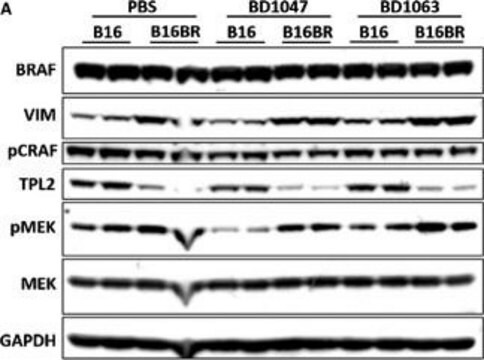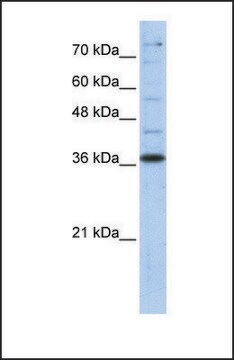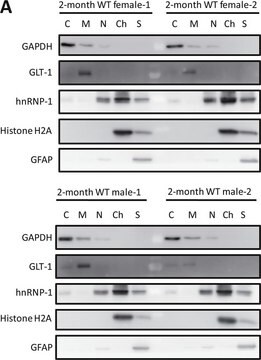SAB1405848
Anti-GAPDH antibody produced in mouse
purified immunoglobulin, buffered aqueous solution
Synonim(y):
G3PD, GAPD, MGC88685
Zaloguj sięWyświetlanie cen organizacyjnych i kontraktowych
About This Item
Kod UNSPSC:
12352203
NACRES:
NA.41
Polecane produkty
pochodzenie biologiczne
mouse
Poziom jakości
białko sprzężone
unconjugated
forma przeciwciała
purified immunoglobulin
rodzaj przeciwciała
primary antibodies
klon
polyclonal
Formularz
buffered aqueous solution
masa cząsteczkowa
antigen ~36.1 kDa
reaktywność gatunkowa
human
metody
indirect immunofluorescence: suitable
western blot: 1 μg/mL
numer dostępu NCBI
numer dostępu UniProt
Warunki transportu
dry ice
temp. przechowywania
−20°C
docelowa modyfikacja potranslacyjna
unmodified
informacje o genach
human ... GAPDH(2597)
Opis ogólny
The product of this gene catalyzes an important energy-yielding step in carbohydrate metabolism, the reversible oxidative phosphorylation of glyceraldehyde-3-phosphate in the presence of inorganic phosphate and nicotinamide adenine dinucleotide (NAD). The enzyme exists as a tetramer of identical chains. Many pseudogenes similar to this locus are present in the human genome. (provided by RefSeq)
Immunogen
GAPDH (NP_002037.2, 1 a.a. ~ 335 a.a) full-length human protein.
Sequence
MGKVKVGVNGFGRIGRLVTRAAFNSGKVDIVAINDPFIDLNYMVYMFQYDSTHGKFHGTVKAENGKLVINGNPITIFQERDPSKIKWGDAGAEYVVESTGVFTTMEKAGAHLQGGAKRVIISAPSADAPMFVMGVNHEKYDNSLKIISNASCTTNCLAPLAKVIHDNFGIVEGLMTTVHAITATQKTVDGPSGKLWRDGRGALQNIIPASTGAAKAVGKVIPELNGKLTGMAFRVPTANVSVVDLTCRLEKPAKYDDIKKVVKQASEGPLKGILGYTEHQVVSSDFNSDTHSSTFDAGAGIALNDHFVKLISWYDNEFGYSNRVVDLMAHMASKE
Sequence
MGKVKVGVNGFGRIGRLVTRAAFNSGKVDIVAINDPFIDLNYMVYMFQYDSTHGKFHGTVKAENGKLVINGNPITIFQERDPSKIKWGDAGAEYVVESTGVFTTMEKAGAHLQGGAKRVIISAPSADAPMFVMGVNHEKYDNSLKIISNASCTTNCLAPLAKVIHDNFGIVEGLMTTVHAITATQKTVDGPSGKLWRDGRGALQNIIPASTGAAKAVGKVIPELNGKLTGMAFRVPTANVSVVDLTCRLEKPAKYDDIKKVVKQASEGPLKGILGYTEHQVVSSDFNSDTHSSTFDAGAGIALNDHFVKLISWYDNEFGYSNRVVDLMAHMASKE
Zastosowanie
Anti-GAPDH antibody is suitable for use in indirect immunofluorescence and western blot.
Postać fizyczna
Solution in phosphate buffered saline, pH 7.4
Oświadczenie o zrzeczeniu się odpowiedzialności
Unless otherwise stated in our catalog or other company documentation accompanying the product(s), our products are intended for research use only and are not to be used for any other purpose, which includes but is not limited to, unauthorized commercial uses, in vitro diagnostic uses, ex vivo or in vivo therapeutic uses or any type of consumption or application to humans or animals.
Ta strona może zawierać tekst przetłumaczony maszynowo.
Nie możesz znaleźć właściwego produktu?
Wypróbuj nasz Narzędzie selektora produktów.
polecane
Kod klasy składowania
10 - Combustible liquids
Klasa zagrożenia wodnego (WGK)
WGK 1
Temperatura zapłonu (°F)
Not applicable
Temperatura zapłonu (°C)
Not applicable
Wybierz jedną z najnowszych wersji:
Masz już ten produkt?
Dokumenty związane z niedawno zakupionymi produktami zostały zamieszczone w Bibliotece dokumentów.
Klienci oglądali również te produkty
Jie Li et al.
Journal of molecular and cellular cardiology, 102, 53-60 (2016-12-04)
Diabetic cardiomyopathy is a major risk factor in diabetic patients but its pathogenesis remains poorly understood. The ubiquitin-proteasome system (UPS) facilitates protein quality control by degrading unnecessary and damaged proteins in eukaryotic cells, and dysfunction of UPS is implicated in
Dong Liu et al.
Journal of molecular cell biology, 8(2), 144-156 (2015-12-30)
Endoplasmic reticulum (ER) stress is involved in ischemic preconditioning that protects various organs from ischemia/reperfusion (I/R) injury. We established an in vivo ER stress preconditioning model in which tunicamycin was injected into rats before hepatic I/R. The hepatic I/R injury
Hong-Pei Yu et al.
Scientific reports, 5, 9853-9853 (2015-05-01)
Previous study revealed that the protective effect of TIGAR in cell survival is mediated through the increase in PPP (pentose phosphate pathway) flux. However, it remains unexplored if TIGAR plays an important role in DNA damage and repair. This study
Hailin Han et al.
Oncology letters, 15(2), 2073-2078 (2018-02-13)
Receptor for activated C kinase 1 (RACK1) is associated with certain aspects of cancer biology and signaling pathways, but its function in pancreatic ductal adenocarcinoma (PDAC) remains unknown. In the present study, 157 patients with PDAC were enrolled. RACK1 mRNA
Qi Xie et al.
Nature neuroscience, 18(4), 501-510 (2015-03-03)
Brain tumor initiating cells (BTICs) co-opt the neuronal high affinity glucose transporter, GLUT3, to withstand metabolic stress. We investigated another mechanism critical to brain metabolism, mitochondrial morphology, in BTICs. BTIC mitochondria were fragmented relative to non-BTIC tumor cell mitochondria, suggesting
Nasz zespół naukowców ma doświadczenie we wszystkich obszarach badań, w tym w naukach przyrodniczych, materiałoznawstwie, syntezie chemicznej, chromatografii, analityce i wielu innych dziedzinach.
Skontaktuj się z zespołem ds. pomocy technicznej









